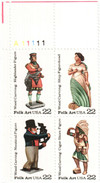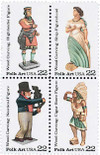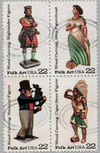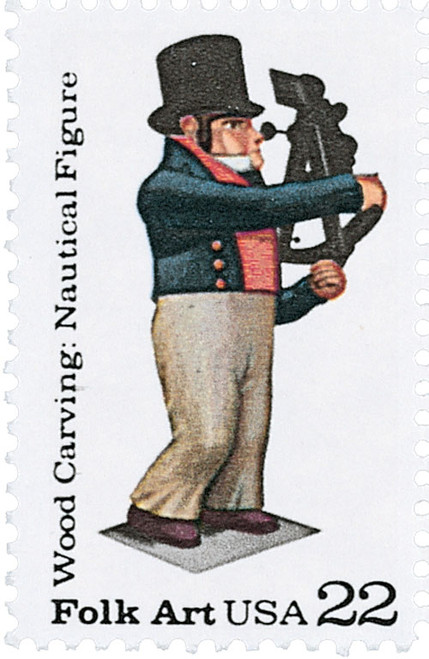
# 2240-43 - 1986 22c Woodcarved Figurines
U.S. #2240-43
1986 22¢ Woodcarved Figurines
American Folk Art Series
- Seventh issue in American Folk Art Series
- Issued in conjunction with the sixth annual National Stamp Collecting Month
- Stamps picture 19th century woodcarved figures used in advertising and to adorn ship hulls
Stamp Category: Commemorative
Series: American Folk Art
Value: 22¢, first-class rate
First Day of Issue: October 1, 1986
First Day City: Washington, DC
Quantity Issued: 240,000,000
Printed by: American Bank Note Company
Printing Method: Photogravure
Format: Panes of 50 in sheets of 200
Perforations: 11
Why the stamps were issued: These stamps pay tribute to the fine artistry of wooden statuettes, which were commonly used for advertising in the 19th century.
About the stamp designs: Bradbury Thompson designed these stamps, using drawings from the Index of American Design by Erwin O. Christensen, which was printed by the National Gallery in 1950. The book was sponsored by the US government as a way to provide work for unemployed artists between 1935 and 1950. The artists made drawings from original carvings and other works for this book. Thompson used the images from this book, enhancing the colors for the stamps.
The Scottish Highlander Figure (#2240) was often used to advertise packets of cigars. While the figure pictured on this stamp was carved in the US, the Highlander had previously been popularized in England to advertise snuff (a type of smokeless tobacco). This statue is considered one of the finest examples of figurine artistry, for its realistic head and larger-than-life hands.
The Ship’s Figurehead (#2241), which held no practical purpose when mounted on the bow of a ship, was a source of pride to the ship’s crew. Early on, figureheads were only head and shoulders, but over time, they became full-length figures. While some stood upright, others were slanted or even nearly horizontal, to follow the contour of the ship. The figurehead shown on this stamp is a combinational of classical and Victorian styles. The hairstyle resembles that of classical sculptures, while the dress is Victorian. The five-foot tall figurehead was carved in the 1800s and leans forward slightly.
The Nautical Figure (#2242) on this stamp originally stood in front of the seafaring shop of James Fales in New Bedford, Massachusetts, in the 1800s. The short sailor is shown holding a large sextant. Nautical figures such as this were frequently stationed outside of shops selling seafaring supplies.
The Cigar Store Figure (#2243) on this stamp is more than six-feet tall. Crafted in the late 1800s, art experts praise its ornamental design with patterns and lines throughout the feathers and costume. Native Americans were one of the most widely-used figures to advertise tobacco shops, because tobacco was considered a gift from the Indians.
First Day City: The First Day ceremony for these stamps was held at the national Gallery of Art in Washington, DC. The ceremony marked the start of National Collecting Month.
Unusual fact about these stamps: Error varieties exist missing perforations.
About the American Folk Art Series: The USPS created the Folk Art Series in 1977 to honor important and lesser-known items in American art and culture. Folk Art is loosely defined as the art of the everyday, rooted in traditions that come from community and culture and expressing cultural identity by conveying shared community values and aesthetics. The series lasted nearly 20 years and featured folk art including Pueblo pottery, quilts, Pennsylvania toleware, Pacific Northwest Indian Masks, duck decoys, Navajo Blankets, wood-carved figures, lacemaking, carousel animals, Indian headdresses, and carousel horses. Click here for more about the series.
History the stamps represent: From the Colonial era through the 19th century, woodcarved figurines were even more widely used than today’s billboards. Few merchants felt competitive without a three-dimensional representative of their products or services.
U.S. #2240-43
1986 22¢ Woodcarved Figurines
American Folk Art Series
- Seventh issue in American Folk Art Series
- Issued in conjunction with the sixth annual National Stamp Collecting Month
- Stamps picture 19th century woodcarved figures used in advertising and to adorn ship hulls
Stamp Category: Commemorative
Series: American Folk Art
Value: 22¢, first-class rate
First Day of Issue: October 1, 1986
First Day City: Washington, DC
Quantity Issued: 240,000,000
Printed by: American Bank Note Company
Printing Method: Photogravure
Format: Panes of 50 in sheets of 200
Perforations: 11
Why the stamps were issued: These stamps pay tribute to the fine artistry of wooden statuettes, which were commonly used for advertising in the 19th century.
About the stamp designs: Bradbury Thompson designed these stamps, using drawings from the Index of American Design by Erwin O. Christensen, which was printed by the National Gallery in 1950. The book was sponsored by the US government as a way to provide work for unemployed artists between 1935 and 1950. The artists made drawings from original carvings and other works for this book. Thompson used the images from this book, enhancing the colors for the stamps.
The Scottish Highlander Figure (#2240) was often used to advertise packets of cigars. While the figure pictured on this stamp was carved in the US, the Highlander had previously been popularized in England to advertise snuff (a type of smokeless tobacco). This statue is considered one of the finest examples of figurine artistry, for its realistic head and larger-than-life hands.
The Ship’s Figurehead (#2241), which held no practical purpose when mounted on the bow of a ship, was a source of pride to the ship’s crew. Early on, figureheads were only head and shoulders, but over time, they became full-length figures. While some stood upright, others were slanted or even nearly horizontal, to follow the contour of the ship. The figurehead shown on this stamp is a combinational of classical and Victorian styles. The hairstyle resembles that of classical sculptures, while the dress is Victorian. The five-foot tall figurehead was carved in the 1800s and leans forward slightly.
The Nautical Figure (#2242) on this stamp originally stood in front of the seafaring shop of James Fales in New Bedford, Massachusetts, in the 1800s. The short sailor is shown holding a large sextant. Nautical figures such as this were frequently stationed outside of shops selling seafaring supplies.
The Cigar Store Figure (#2243) on this stamp is more than six-feet tall. Crafted in the late 1800s, art experts praise its ornamental design with patterns and lines throughout the feathers and costume. Native Americans were one of the most widely-used figures to advertise tobacco shops, because tobacco was considered a gift from the Indians.
First Day City: The First Day ceremony for these stamps was held at the national Gallery of Art in Washington, DC. The ceremony marked the start of National Collecting Month.
Unusual fact about these stamps: Error varieties exist missing perforations.
About the American Folk Art Series: The USPS created the Folk Art Series in 1977 to honor important and lesser-known items in American art and culture. Folk Art is loosely defined as the art of the everyday, rooted in traditions that come from community and culture and expressing cultural identity by conveying shared community values and aesthetics. The series lasted nearly 20 years and featured folk art including Pueblo pottery, quilts, Pennsylvania toleware, Pacific Northwest Indian Masks, duck decoys, Navajo Blankets, wood-carved figures, lacemaking, carousel animals, Indian headdresses, and carousel horses. Click here for more about the series.
History the stamps represent: From the Colonial era through the 19th century, woodcarved figurines were even more widely used than today’s billboards. Few merchants felt competitive without a three-dimensional representative of their products or services.


















